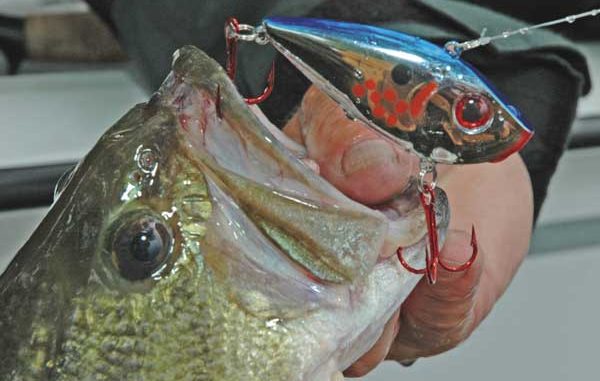
Here’s a look at some more trophies that were dropped during the 2007-08 season.
During the early part of March, the bass will be preparing to spawn, and later in the month, the bass will either be in the spawn or the post-spawn.
Therefore, March is a great month to fish Bayou Segnette near New Orleans. Catching and releasing 30 to 40 bass, weighing from 1/2 to about 4 pounds each per day in this area in March isn’t uncommon.
I’ll be targeting any type of cover in the dead-end canals where I can find clear water in their back ends. In March, the larger bodies of water will be heavily stained or muddy.
First-light pattern
I’ll start buzzing the Rage Toad on the surface at first light. Generally, this part of the state doesn’t have much cold weather in March, so the top-water bite will be strong at first light.
This bait has a lot of action and makes a unique noise different from other frog-type baits. Some bass still will be sitting on their nests, while other bass will be guarding the fry. The bass will be aggressive, and they’ll attack any topwater lure near their fry.
I prefer to fish with the Tru-Tungsten Greg Hackney “Hack Attack” M-Bend Frog Hook with double hooks. Since the Rage Toad isn’t a conventional toad, it can roll to the left or to the right when you’re retrieving it.
However, with the Frog-Hook, which is specially designed for this type of toad, you get better hook ups. Also, the shanks of the hooks act like a keel on a boat to make the toad swim true and straight. I like the No. 5/0 set of hooks because with this size toad and hook system, every time the toad hits the water, it usually lands with the hooks up.
Early in the morning, I’ll be casting to any cover I can locate, like pilings, sea walls and grass with the black neon or junebug colors. Since the grass has returned in this region. I’ll fish with 50-pound-test braided line tied directly to the hooks and the Rage Toad on a 7-foot, 2-inch Quantum PT rod with a PT Burner 7:1 gear ratio reel. I prefer the higher gear-ratio reel to keep the Toad on top of the water easier with less effort than if I use a lower gear-ratio reel.
I keep the Toad coming to the boat on a steady retrieve, because I’ve learned that if you stop the bait, the bass often will miss it when they strike. Bass can key in on the bait and will attack it better if it’s reeled in steadily. Some days the bass want the bait moving really slowly and only gurgling on the surface. Other times the bass prefer the bait to move fast and splash on the surface.
Zero out on Segnette
After the first hour or two of daylight, I’ll fish a Zero in green pumpkin, junebug or black neon. In clear water, I’ll be fishing the green pumpkin more, and in darker water, I’ll be fishing the junebug or the black colors more.
I’ll Texas rig the Zero without a sinker, and fish it around any cover I can locate in the water. If I’m fishing grass, I’ll pitch it to the holes in the grass or the grass edges, and let it fall.
To catch Bayou Segnette bass on a cigar-shaped worm, like the Zero, you’ll have to fish it on a totally slack line and not give the bait any action from the time it hits the water until it lays on the bottom motionless for 10 to 20 seconds.
Then, I’ll twitch the Zero one time to make it come up off the bottom and allow it to sink to the bottom again on a slack line. If I still haven’t gotten a bite, I’ll reel it in and make another cast.
I’ll be using a No. 4/0 offset worm hook in the Zero on 16- to 20-pound-test Gamma fluorocarbon line. A dense line, the fluorocarbon makes the Zero sink a little faster, giving the bait more action. Monofilament line has a tendency to float, and I want the bait to sink.
When the bass takes the bait, you’ll just see your line move off to the side. Or, when you start to pick up your bait off the bottom, your lure will feel like it has grass on it. That’s when you need to set the hook hard and fast. Even if a bass strikes the bait hard, you won’t feel that strike because you’re fishing with a slack line.
Red Eye a good bet
Also, at Bayou Segnette, I’ll be fishing a lipless crankbait like the Red Eye Shad. If the water’s clear, I prefer the red and orange colors. In stained water, I like chartreuse. The dirtier the water, the slower I’ll reel the Red Eye Shad, but still use a steady retrieve.
This crankbait has a really loud rattle in it. So if the water’s dirty, a bass will feel the vibrations from the rattle before it actually sees the lure and hone in on the sound to pinpoint the bait.
I prefer to fish cleaner water, but if there’s really dirty water at those intersections, I’ll fish the Redfish Magic, a spinnerbait with a soft-plastic body and a single gold blade.
Although this lure’s designed for redfish, it’s deadly on bass in March in heavily stained water due to its heavy thumping sound when the blades turn.
Normally in March, a good bit of fresh water comes into this area. More than likely, you won’t catch speckled trout and redfish at these canal junctions like you will in the summer and the fall.


